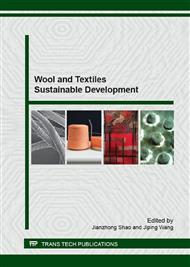p.317
p.324
p.331
p.338
p.347
p.356
p.363
p.369
p.378
Extended Studies on Fibre Diameter Measurement with OFDA Instrument
Abstract:
OFDA 2000 is a widely used fibre diameter measurement instrument. The instrument can provide improved statistical accuracy measurements in comparison with traditional technology. In this paper, a new technique has been developed to enable fibre diameters to be measured in an aqueous environment using the OFDA 2000 instrument. This new technique was utilised to assess the effects of pH and temperature on the diameters of Merino wool fibres in aqueous environments. Significant changes in fibre diameter under aqueous conditions were found as a function of pH and temperature. It is also demonstrated in this paper that the fibre diameter measurement results can be affected by fibre colour. In both dry and aqueous conditions, variation in fibre diameter was observed on fibres with different colours. This could be due to an optical effect or more likely due to physical changes in the dyed fibres as a result of the presence of dyes. Apart from their physical bulk, dyes may also affect the water content of fibres and hence have an influence on the swelling of fibres when they are measured under ambient regain and wet conditions.
Info:
Periodical:
Pages:
347-355
Citation:
Online since:
November 2015
Authors:
Keywords:
Price:
Сopyright:
© 2016 Trans Tech Publications Ltd. All Rights Reserved
Share:
Citation:


